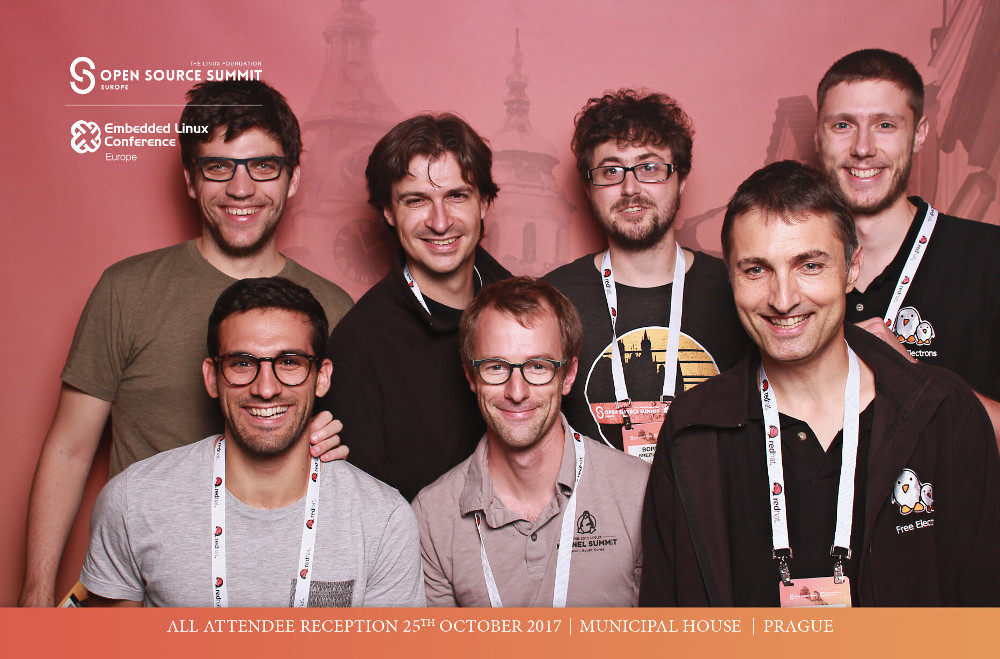Bootlin participated to the Embedded Linux Conference Europe last week in Prague. With 7 engineers attending, 4 talks, one BoF and a poster at the technical showcase, we had a strong presence to this major conference of the embedded Linux ecosystem. All of us had a great time at this event, attending interesting talks and meeting numerous open-source developers.

In this first blog post about ELCE, we want to share the slides and videos of the talks we have given during the conference.
SD/eMMC: New Speed Modes and Their Support in Linux – Gregory Clement
 Since the introduction of the original “default”(DS) and “high speed”(HS) modes, the SD card standard has evolved by introducing new speed modes, such as SDR12, SDR25, SDR50, SDR104, etc. The same happened to the eMMC standard, with the introduction of new high speed modes named DDR52, HS200, HS400, etc. The Linux kernel has obviously evolved to support these new speed modes, both in the MMC core and through the addition of new drivers.
Since the introduction of the original “default”(DS) and “high speed”(HS) modes, the SD card standard has evolved by introducing new speed modes, such as SDR12, SDR25, SDR50, SDR104, etc. The same happened to the eMMC standard, with the introduction of new high speed modes named DDR52, HS200, HS400, etc. The Linux kernel has obviously evolved to support these new speed modes, both in the MMC core and through the addition of new drivers.
This talk will start by introducing the SD and eMMC standards and how they work at the hardware level, with a specific focus on the new speed modes. With this hardware background in place, we will then detail how these standards are supported by Linux, see what is still missing, and what we can expect to see in the future.
Slides [PDF], Slides [LaTeX source]
An Overview of the Linux Kernel Crypto Subsystem – Boris Brezillon
 The Linux kernel has long provided cryptographic support for in-kernel users (like the network or storage stacks) and has been pushed to open these cryptographic capabilities to user-space along the way.
The Linux kernel has long provided cryptographic support for in-kernel users (like the network or storage stacks) and has been pushed to open these cryptographic capabilities to user-space along the way.
But what is exactly inside this subsystem, and how can it be used by kernel users? What is the official userspace interface exposing these features and what are non-upstream alternatives? When should we use a HW engine compared to a purely software based implementation? What’s inside a crypto engine driver and what precautions should be taken when developing one?
These are some of the questions we’ll answer throughout this talk, after having given a short introduction to cryptographic algorithms.
Slides [PDF], Slides [LaTeX source]
Buildroot: What’s New? – Thomas Petazzoni
 Buildroot is a popular and easy to use embedded Linux build system. Within minutes, it is capable of generating lightweight and customized Linux systems, including the cross-compilation toolchain, kernel and bootloader images, as well as a wide variety of userspace libraries and programs.
Buildroot is a popular and easy to use embedded Linux build system. Within minutes, it is capable of generating lightweight and customized Linux systems, including the cross-compilation toolchain, kernel and bootloader images, as well as a wide variety of userspace libraries and programs.
Since our last “What’s new” talk at ELC 2014, three and half years have passed, and Buildroot has continued to evolve significantly.
After a short introduction about Buildroot, this talk will go through the numerous new features and improvements that have appeared over the last years, and show how they can be useful for developers, users and contributors.
Slides [PDF], Slides [LaTeX source]
Porting U-Boot and Linux on New ARM Boards: A Step-by-Step Guide – Quentin Schulz
May it be because of a lack of documentation or because we don’t know where to look or where to start, it is not always easy to get started with U-Boot or Linux, and know how to port them to a new ARM platform.
Based on experience porting modern versions of U-Boot and Linux on a custom Freescale/NXP i.MX6 platform, this talk will offer a step-by-step guide through the porting process. From board files to Device Trees, through Kconfig, device model, defconfigs, and tips and tricks, join this talk to discover how to get U-Boot and Linux up and running on your brand new ARM platform!
Slides [PDF], Slides [LaTeX source]
BoF: Embedded Linux Size – Michael Opdenacker
This “Birds of a Feather” session will start by a quick update on available resources and recent efforts to reduce the size of the Linux kernel and the filesystem it uses.
An ARM based system running the mainline kernel with about 3 MB of RAM will also be demonstrated.
If you are interested in the size topic, please join this BoF and share your experience, the resources you have found and your ideas for further size reduction techniques!

Great to see you guys still going strong!
wrt the talk on SD/eMMC speed modes and Linux support, specifically with regard to UHS-II: Don’t think I saw a link to video for this talk, so I’m not sure if this was discussed, but in case you may not have seen it yet I thought you may want to take a look at this old RFC patch:
https://www.spinics.net/lists/linux-mmc/msg30007.html